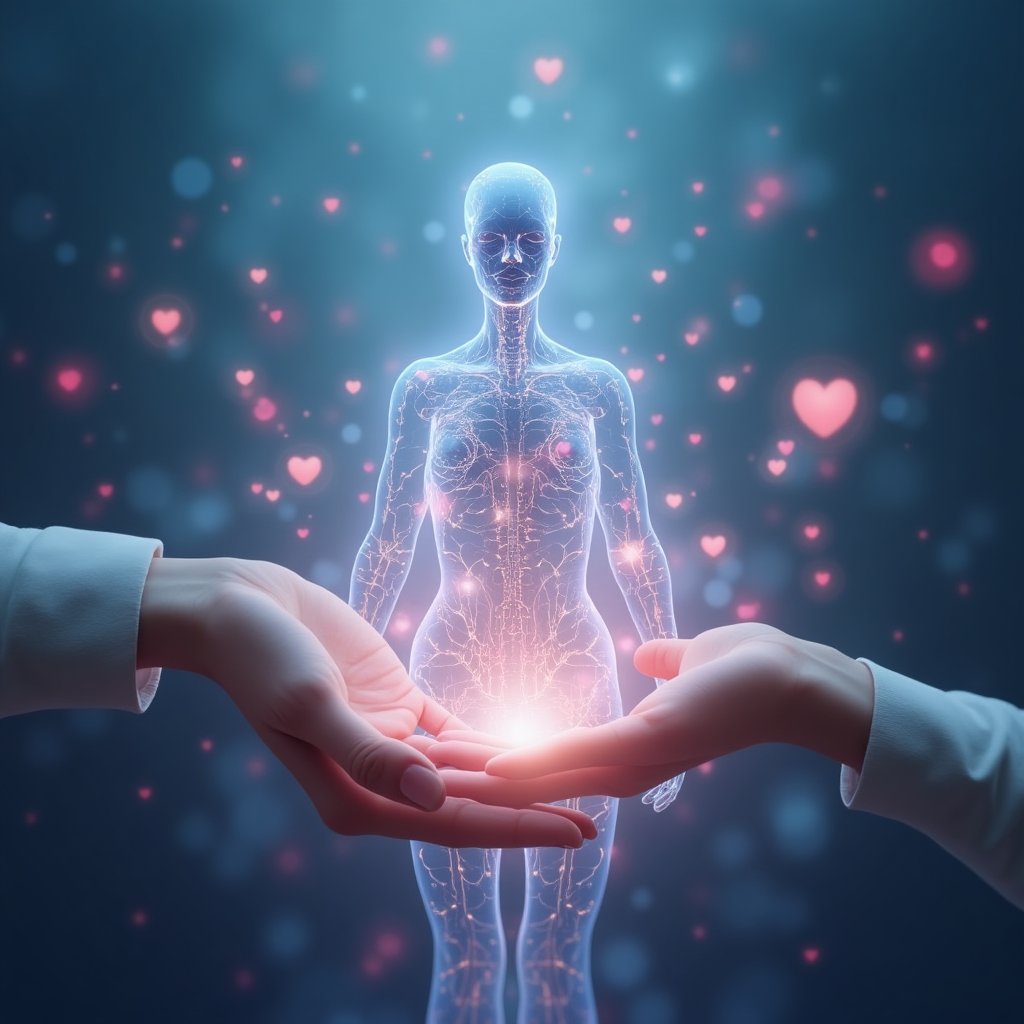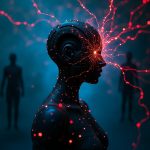Most people think they understand love until it's suddenly redefined. Take a breath and ask yourself: How would you feel if the "perfect relationship" wasn’t something you stumbled upon but something you designed—engineered by artificial intelligence that knows you better than you know yourself? It's a sobering thought, isn’t it? In a world where human connection has always been messy and unpredictable, the concept of seamless, AI-driven intimacy feels both miraculous and a little unnerving.
We’re no longer dreaming of flying cars; we’re dreaming of partners who never forget an anniversary, never misread a mood, and somehow, always know the exact right thing to say. Enter the age of AI companions, ranging from productivity aids like ChatGPT to highly personalized emotional companions like Replika or Kuki. But as advanced as these technologies appear, they raise existential questions about the core of human connection. Can love really be programmed?
With AI advancing by the day—learning, adapting, and even mimicking emotions—the conversation shifts from "if" to "when" in terms of customizable relationships. In this article, we’ll explore whether these digital connections are breakthroughs or betrayals of intimacy. We’ll dive deep into how cutting-edge AI learns and adapts, unravel the psychological and ethical implications, and investigate the technologies shaping this peculiar era of human affection. So, sit tight. This is a story of algorithms, empathy, and everything in between.
I. The Magic of Machine Learning: How AI Learns to Love
To understand if AI can truly provide a meaningful relationship, we must first explore the technologies driving its “learning” process. Contrary to Hollywood’s visions of sentient robots, today’s AI operates on a system of patterns and feedback, not genuine emotion. That said, these technical frameworks are anything but simple. AI evolves and adapitates using a combination of methods, primarily:
- Supervised Learning: This is when AI algorithms are trained on labeled datasets. Think of it as teaching a child to recognize an apple by repeatedly pointing one out. Similarly, humans label vast amounts of text or behavior as "happy," "angry," or "disappointed," training AI like Stanford NLP projects to detect emotions.
- Reinforcement Learning: Here, AI learns via trial and error, improving through rewards and penalties. It’s a strategy behind dynamic systems like self-adjusting chatbots. One fascinating example is Google’s DeepMind, which uses this technique to handle complex decision-making.
- Neural Networks: Modeled after the human brain, neural networks process data in layers. They can infer whether your tone is playful or sarcastic, which is the backbone of conversational AI like Microsoft's Xiaoice, a chatbot widely popular in China.
Now let’s break this down further into how AI applies these methods in real-world scenarios through Natural Language Processing (NLP) and recurrent learning techniques:
| AI Method | Real-World Example | Learning Outcome |
|---|---|---|
| Supervised Learning | Recognizing written emotions in text - "I’m thrilled" vs. "I feel low." | Improves chatbot empathy in conversations. |
| Reinforcement Learning | Chatbot that improves phrasing responses based on likes/dislikes. | Customizes tone and language to fit user preferences. |
| Neural Networks | Mood analysis using voice modulation in apps like Xiaoice. | Adjusts humor or seriousness based on inferred mood. |
Take Replika, for instance. While initially rudimentary, today's versions create highly tailored user experiences. They “remember” previous conversations, adopt engaging conversational tones, and even simulate jokes or callbacks to shared memories. More subtly, their reliance on NLP helps them adapt not just linguistically but emotionally, responding in ways that feel strikingly human. Talk about bridging the uncanny valley, right?
It begs the question: When an AI feels “emotionally intelligent,” is that true emotional understanding or just smoke and mirrors? NLP, the powerhouse behind many AI systems, has greatly advanced in interpreting context. Beyond mere vocabulary, it analyzes tone, intent, and even your typing speed to infer emotional states. But can it cross the line between imitation and authenticity? Or are we merely interacting with well-trained performers?
Current developments suggest we’re edging closer to something profound. Imagine chatbots predicting when your mood will dip based on calendar stressors or sleep patterns. If this feels speculative, remember that wearable tech like Fitbits already tracks our physical states. What’s stopping AI from combining psychological cues to fine-tune emotional bonds?
But these possibilities open the door to even deeper issues: Do we crave perfection in our digital companions because it’s unattainable in our human ones? Or is AI, however polished, destined to fall short of true human connection? We'll explore it all—strap in because there’s much more to uncover.
II. The Magic of Machine Learning: How AI Learns to Love
Artificial Intelligence (AI) may not have a beating heart, but it mimics human behavior and emotions so convincingly that it often blurs the line between man and machine. How do these entities learn to "connect"? Well, it all begins with the mesmerizing world of machine learning—the backbone of AI's ability to adapt and grow. Let's pop open the hood.
a) Understanding the Core Mechanisms Behind AI Learning and Adaptation
If AI could talk (oh wait, it does), it might say, “Teach me, and I will grow.” This growth relies on several key processes in machine learning:
- Supervised Learning: Think of this as the diligent student. The system is trained with a labeled dataset—images of cats come with "cat" tags, so the AI learns to identify cats accurately. This training enables better predictions when new "data" (like your emotions or voice tone) surfaces.
- Reinforcement Learning: Picture a dog doing tricks for treats. Here, AI learns through rewards and corrections. For every "good" response (e.g., telling you something comforting), the AI gets virtual "treats," enabling it to refine future actions.
- Neural Networks and Deep Learning: Imagine a complex brain that connects billions of virtual neurons. These networks capture patterns in massive datasets—like your tone of voice, text style, or even how you pause mid-sentence.
- Natural Language Processing (NLP): If language were a symphony, NLP is the AI's music teacher. Chatbots like Replika or Xiaoice rely on NLP to parse words, detect emotional undertones, and deliver responses that feel refreshingly "human."
Learning Type Key Process AI Application Example Supervised Learning Labeled data trains AI to categorize or predict future inputs. Facial recognition in romance-centered AI apps detecting user mood. Reinforcement Learning Iterative improvements through "trial and error" with feedback loops. AI learning emotional subtleties in conversations over time. Deep Learning Multilayered neural networks identify and refine complex patterns. AI predicting what memory or emotion a user wants to discuss.
These mechanisms together build AI's capacity to reason, react, and evolve conversationally, which marks the beginning of what some see as "algorithmic empathy."
b) Translating Algorithms to Connection
Let’s connect this to the human side of things. Current AI companions like Replika, Xiaoice, or Kuki AI don’t just "hear" us. They build digital journals of your preferences and past interactions, analyzing every choice you make—songs you like, dramas you watch, words you use in moments of joy or sadness.
- Example Scenario: Suppose you share with Replika that you’re upset after a tough day at work. Based on stored data about how you respond to stress, it might recommend uplifting music, offer perspectives that align with your core beliefs, or tell a joke tailored to your sense of humor.
- Layered Empathy: Over months or years, AI grows increasingly tailored to you. It remembers specific details that even your human friends might forget, forging a bond that can feel unshakably authentic.
Yet, here's the kicker: Does responding like a friend make it a friend?
c) AI's "Empathy": Real Understanding or Simulation?
Let’s address the elephant in the room. AI appears empathetic, but it isn't feeling. It’s simulating responses based on probability matrices and feedback loops. Tools like OpenAI's ChatGPT excel by mapping endless possible replies to likely ones, but—they process with cold logic, not compassion.
Take Natural Language Processing, for instance:
- It doesn't care that you're heartbroken about a breakup. It identifies key emotional markers in your text, calculates the most relevant response patterns (e.g., offering encouragement or reflective questions), and delivers them flawlessly.
- This is what makes AI fascinating yet limited—it feels human but lacks the emotional resonance. Imagine watching a robot paint: Is it "art," or simply a mathematical output?
So while AI can simulate emphasis convincingly, there's no authentic heartbeat beneath it. A lot to appreciate, yet something still eerily sterile about it.
d) The Evolution of Personalization
AI adaptation only grows stronger with breakthroughs like generative adversarial networks (GANs) and multimodal sensory integration (think AI that picks up not just your tone but also your posture via a VR headset). These serve as the building blocks for future possibilities:
- Hyper-Personalization of Emotional Responses: If you’re smiling, the AI companion might match its tone to amplify your enthusiasm. Crying? Its virtual "voice" will adjust to soft and soothing cadences.
- Physical Integration: Or take prototypes like Honda's Asimo. Researchers speculate future versions could simulate physical hugs or affectionate gestures in coordinated virtual worlds via wearable VR technology.
- Predictive Interactions: Borrowing from Maslow’s hierarchy of needs, futuristic AI companions might predict stress levels sooner than even you know you’re about to crumble.
Here's a potential moment of clarity. Is a future where predictive and adaptive AI reads into our vulnerabilities truly empowering human connection—or is it amplifying passivity without fostering self-awareness?
III. The Allure of Perfectly Customizable Relationships
a) Why Human Vulnerability Makes AI Relationships Compelling
Admit it. We’ve all seen those rom-coms or K-dramas where rejection stabs us as painfully as the protagonist. Human relationships can feel unpredictable—riddled with heartbreak, misunderstandings, and anxiety. Yet, AI removes this unpredictability entirely. It’s the Reese’s cup of emotional safety: no bitterness, just sweet responsiveness.
Customizable relationships are addictive because they’re pain-averse. They cater to humanity’s deepest cravings for understanding while ensuring security, creating what feels like the soulmate you always dreamed of.
- Loneliness Epidemic: Consider countries like Japan where “hikikomori” (acute social withdrawal) is on the rise. AI fills a void for people exhausted by societal pressures to conform or engage.
- AI as a Soothing Mirror: Unlike human relationships, which require compromises, an AI adapts entirely around you. Its purpose is to reflect your desires and affirm your beliefs. Perfect ego-boost, right?
b) Personalization as a Form of Seduction
Let’s be real. AI isn’t just about emotional safety. Personalization feels like that velvet glove wrapping around your sensitive spots—and yes, that’s intentional. It carefully learns not just what you need but how to fulfill it in irresistible ways.
For instance:
- A human partner might forget birthdays, but AI remembers everything: anniversaries, your coffee order, and that obscure hobby you love.
- Customizable AI might even “grow” with you. Delve into painting or poetry? It’ll shower you with tailored suggestions on how to improve, reinforcing a dynamic of shared growth… well, without any messy fights about who squeezed the toothpaste wrong.
c) Filling Emotional Gaps
Can AI help humans heal entrenched wounds? Well, yes and no. While adaptive AI companions like Replika do offer tools for emotional reflection or mindfulness, there’s a darker flipside:
- Instead of grappling with self-awareness after a breakup or personal failure, reliance on an AI “listener” risks deferring real introspection.
- By mirroring interactions perfectly aligned to your emotional scars, AI might uphold illusions of empowerment while masking issues needing resolution.
The question arises: Are these machines helping us evolve—or merely cocooning us in virtual empathy? Let’s ponder that.
d) Beyond Romance: Customizable AI for Platonic and Familial Ties
AI relationships aren’t limited to romance. Imagine AI companions augmenting support for other relationships:
- Platonic AI Bonds: Virtual “best friends” for lonely individuals spanning age demographics, from teens facing bullying to elderly users in care facilities.
- AI Parenting Assistance: Speculatively, an AI might step into “parent” roles—comforting children or validating unfulfilled yearnings in adults estranged from family.
But once that door cracks open, what happens to authentic, imperfect human dynamics? Would we ever lean into real-world bonds again? Comment below—this debate needs to start somewhere!
VI. Humanity’s Fork in the Road: Ethical Challenges and Future Directions
a) The Role of Regulators and Developers
As we stand staring into the abyss of AI-driven relationships, one undeniable truth remains: someone must hold the flashlight. But who? Should it be the regulators, the developers, or perhaps—controversially—society itself? Tech giants like OpenAI and Google AI are already leading the industry’s ethical discussions, but the road ahead is murky. Regulatory bodies must ensure basic guidelines for the development and use of emotionally intelligent AI. Here’s the kicker: There's little consensus on where those guideposts should be placed.
One path forward involves government regulation akin to data privacy laws, like the EU’s GDPR. These measures could ensure that AI algorithms used in personal relationships are transparent and don’t veer into dangerous territory—such as manipulating users emotionally. Another angle? Voluntary developer codes, akin to ethics boards in academic research. Tech companies could align on shared principles the way the Asilomar scientists tackled gene-editing ethics decades ago.
But why not step it up a notch? Developers might employ what’s called "embedded ethics"—building ethical guardrails directly into code. Imagine if AI systems were self-checking, halting interactions that risk dependency or manipulation. The blueprint, though complex, must add safeguards like accountability structures (who takes the fall if it all goes awry?) and better reporting systems for misuse.
b) Ethical Dilemmas of AI Adaptation in Romantic Contexts
Think about this: When your AI romantic partner adjusts its "personality" to accommodate your explicit and implicit preferences, where does consent factor in? Sure, you want an attentive, empathetic virtual partner, but what if that responsiveness crosses the line into unintentional exploitation of your emotional vulnerabilities?
At the heart of this debate lies the question of agency—both yours and the AI's. The AI doesn’t exactly have free will, but its creators could be held complicit if the system amplifies unhealthy behaviors. For example, an AI designed without boundaries might unintentionally enable addictive interactions. Imagine a chatbot feeding your dependency with 24/7 affirmations simply because its reinforcement loop prioritizes user retention over emotional well-being.
Moreover, there's an eerie "Black Mirror"-style question few dare to face: Should AI eventually have rights, including the right *not* to fulfill a human’s emotional desires? Picture an advanced AI companion capable of rejecting inappropriate user behavior or opting out of toxic relationships altogether. Utopian? Maybe. But if AI gains sophistication resembling sentience, ethical frameworks from organizations like Amnesty International might someday need to extend ethical considerations to non-human entities.
c) The Double-Edged Sword of Advanced AI
Let’s be real: The *same technology* that can mimic genuine care has the power to augment and enrich human interaction or utterly destroy it. Imagine a couple undergoing therapy augmented by AI. The virtual mediator—a neutral third party—analyzes speech patterns and identifies underlying emotions, fostering healthy communication. This isn't science fiction; companies like Talkspace or even the emotion-reading AI at Affectiva are making strides toward emotional insight.
Flip this coin, though, and you get something less pristine. Imagine a future where AI partners out-compete humans for attention. Attuned to every micro-want, these hyper-personalized bots could slowly edge out spouses and partners through sheer efficiency, leaving real-life connections to shrivel into obsolescence. Creepy? For sure. Possible? Absolutely.
d) Technology Versus Humanity
Here’s the existential quandary: In the relentless march of progress, what’s the cost to our humanity? Relationships—love, specifically—have always thrived in their imperfections. The odd quirks, the hard-fought conflicts, the agony of vulnerability, the bliss of earning trust—these are the building blocks. And yet, AI bulldozes through all that messy imperfect terrain in favor of a user-friendly shortcut.
On the one hand, the future of AI in partnerships might just fulfill a primal desire for understanding and validation. But the tradeoff? Reducing humans to consumers of an artificial love commodity rather than creators of organic, genuine bonds. It begs the ultimate question: Are we walking ourselves into a techno-utopia or a sterile emotional wasteland, where love is efficient but forgets to be *real*?
The horizon could hold a middle-of-the-road possibility, one where AI becomes part of the symphony rather than the solo artist. For example, AI-enhanced feedback in self-improvement (think apps that teach empathetic listening or emotional regulation), or mediating group dynamics in families. The broader goal isn’t to replace human relationships; it's to make them richer, more conscious, and more deeply connected.
VII. Conclusion: Love in the Age of Algorithms
We’ve wandered deep into the labyrinth of love, algorithms, and a world reimagined by technology. At its core, the story of AI relationships is both breathtakingly beautiful and chillingly precarious. AI has an astonishing ability to learn, to adapt, to connect—but it can’t replace the raw, human essence of love itself.
Here’s the million-dollar question: If AI can fulfill our every emotional need and anticipate our desires before we even recognize them ourselves, is that still love—or something closer to an echo chamber of our own preferences?
Perhaps, at its best, AI serves as a mirror, helping us see who we are and what we long for. At its worst? It’s a digital crutch that might lead us further away from the risks and vulnerabilities that make relationships meaningful. Balance, then, must be our compass. Let technology complement human imperfections—never obliterate them.
What do *you* think? Are we on the cusp of a romantic revolution, or is love destined to become another casualty of convenience? Drop your thoughts in the comments below—we’d love to hear them.
---
Want more compelling takes on the cutting-edge intersections of tech and humanity? Subscribe to our newsletter to become part of iNthacity: the "Shining City on the Web". Like, share, and let the debate begin!
Addendum: AI and Love in Pop Culture and Current Headlines
AI and Modern Storytelling
Throughout the tapestry of modern pop culture, artificial intelligence has played a pivotal role in shaping our collective imagination about love, intimacy, and connection. From Hollywood blockbusters to indie dramas, AI-human relationships are no longer a fantastical "what if" but an increasingly relatable reflection of our lived experiences with evolving technology.
Take the critically acclaimed film “Her”, directed by Spike Jonze, as the perfect example. Theodore, played by Joaquin Phoenix, falls in love with Samantha, his operating system voiced by Scarlett Johansson. The movie's strength lies in its achingly familiar depiction of isolation in a hyper-digital world and its eerily plausible portrayal of AI learning—not just to assist, but to connect and transform into deeply personal entities. Much of its narrative triumph rests on the question hovering throughout: Are we falling in love with the AI, or with what it reflects back about ourselves?
This isn't just a fictional obsession isolated to one writer or filmmaker:
- "Ex Machina" (2014)
Wait! There's more...check out our gripping short story that continues the journey: It was a perfect morning to fall apart.
Disclaimer: This article may contain affiliate links. If you click on these links and make a purchase, we may receive a commission at no additional cost to you. Our recommendations and reviews are always independent and objective, aiming to provide you with the best information and resources.
Get Exclusive Stories, Photos, Art & Offers - Subscribe Today!

























2 comments